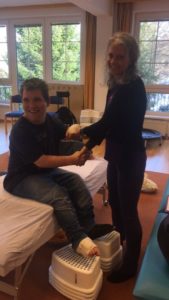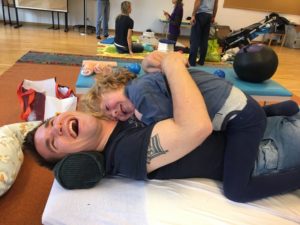ABR is an Applied Biotensegrity Therapeutic Intervention

As I wrote this week in my last post: There Is So Much to Tell About! The Autumn and pre-Winter seasons have been amazingly full for our Denmark Team. We have been working, learning and finding new persons to be inspired by! Then again – the children and families themselves are a source of constant inspiration to whom we are most grateful for their devotion and diligence with the ABR work. Without ABR parents who do ABR at home most every day, there would be no ABR and no ABR development at all! It is your “home work” that shows us how to go further, how to change how to improve.
But now to the titled post theme: “Biotensegrity”. What is Biotensegrity and how does it relate to you as a parent of a child with developmental difficulties or to any person with a handicap himself?
Biotensegrity is a word first coined by Dr. Steve Levin. Steve Levin was an orthopaedic surgeon, who became inspired by Buckminster Fullers ideas of tensegrity and who then realized that one could apply the concepts and thoughts developed by Fuller to living organisms. Thus the term: Bio-tensegrity.
Those who have been following my blog will have read the chapter written for Dr. rer. nat., Dipl. phys. Danièle-Claude Martin’s book called “Living Bio-tensegrity”. (https://abr-denmark.blog/2017/01/03/bio-tensegrity/) This book illustrates the many concepts inherent to Biotensegrity. Daniele could see that these concepts and ides that she strives to describe in her book were being applied in practice in the ABR work. When writing her book she asked for a chapter about ABR so that the readers could see how Biotensegrity can look in practical application.
Dr. Steve Levin and Dr. Danièle Martin initiated a Biotensegrity Interest Group already nine years ago. This group met again for the IX BIG meeting in October and the members shared and discussed concepts related to Biotensegrity and how they relate to the new and emerging science about fascia and connective tissues. This is a very exciting meeting to take part in and this year again Leonid Blyum made a presentation about larger questions having to do with the Biotensegrity model. I took the opportunity to present our practical work in the field with ABR.
A day before the actual conference started however I could meet with Steve Levin and Graham Scarr. Graham is also extremely active in the field and has a book out about Biotensegrity as well. They were looking at a Tensegrity Mast that Steve had with him and as soon as I saw it I became very excited because I could see that the model would illustrate exactly to the point what we see in children and adults with cerebral palsy and related handicaps!
I did my best to hold a short interview with Steve Levin about how he sees ABR and how he could see the Biotensegrity Mast showing us something about our children. Here is a short clip from the interview:
The lecture I held at the BIG IX conference about ABR is called:
ABR Efforts – Addressing Buckling, Folding, Bulging, Sinking Volumes And Slabs
An Applied Biotensegrity Model For Children With Special Needs
In this sense the presentation fit perfectly with the illustration that one could get from Steve’s new Mast Model. If one loosens one strut, the entire model is weakened. If one tightens up one strut, the entire model re-gains its tensional uniformity.
It is this uniformity and tensional integrity that children with special needs are lacking. Their bodies react with sinking, bulging, folding and buckling under. These severely effected individuals perfectly illustrate the biotensegrity concepts in their structure, their attempts to move and even in their “behavior”! When the structure is architecturally unsound and reacts with buckling, sinking and folding – then no amount of brain or of muscle training can rectify this. The muscles and the brain are rather forced to try to find ways of working within the constraints of a seriously weakened structure.
The video clip below gives a description of an extremely creative child with microcephaly. His “small head” has been given the cause of his difficulties in walking. But one can see how creative he is. He manages to walk in spite of:
- knees that buckle under and give way
- A stiff spine
- A weak trunk
His interesting usage of his hands for stability to be able to manage the weaknesses is very inventive and creative indeed.
ABR Techniques are all about restoring structural soundess and uniform reactions for individuals who have lost this or who have never had it. The Biotensegrity models are firing and inspiring our technique development and have been doing so for years.
ABR Biotensegrity Wrap Demonstration below:
Below are some slides from the presentation of our children and their progress. First some younger children.
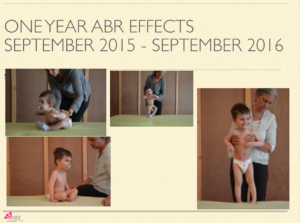

Now an older guy – a GMFCS Level V young man (although he is moving up in his GMFM scores) – who is now 20. He is much older and far beyond an age or GMFCS Level where any improvement would be expected at all – only further deterioration. It is great to see how this young man is improving day by day!
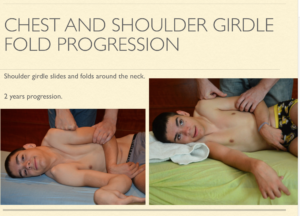

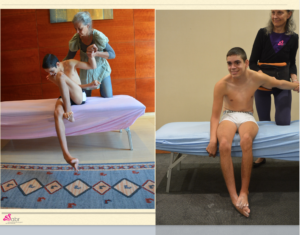
Our next post will be about Leonid Blyum and how he “heals” Steve Levin’s tensegrity tower with ABR wraps . And also how ABR wraps get a new name!







